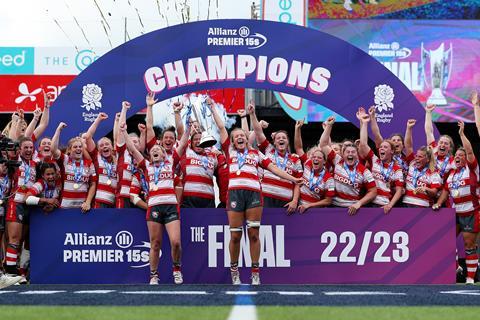Alex Brown, head of sport and entertainment at EssenceMediaCom, looks at the opportunities in a Women’s Rugby World Cup year

Whilst the Men’s Six Nations is currently gripping both casual and hardcore rugby fans in the UK with its annually served diet of excitement and drama, potentially the biggest opportunity for the sport in the UK in 2025 lies within the women’s game, with this year’s Rugby World Cup promising to supercharge the sport in terms of audience numbers and revenue.
There’s no doubt that since the last women’s RWC in 2021, which itself broke records, the sport in the UK has continued to develop, with women’s rugby in this country fast approaching its breakthrough moment, much like women’s football a few years ago.
There are around 1.5 million dedicated women’s rugby fans in the UK. And this shows – more than 220,000 tickets have already been sold for this summer’s World Cup, set to be the best-attended women’s edition in history.
For broadcasters, the tournament presents a golden opportunity to engage new fans – as long as they tailor their coverage to meet the unique needs of this growing audience.
A distinct audience
Women’s rugby is riding on the crest of a wave. Last year’s Women’s Six Nations was the most viewed on record, with 8.1m tuning in for three minutes or more, a 33% increase from the previous year. In addition, the domestic league continues to expand.
The sport is also growing increasingly popular among women – Statista data shows that 42% of the 2023 Women’s Six Nations viewers were female, up from 37% in 2022.
Yet, despite this surge in interest, women’s rugby is still in its early stages compared to the men’s game in terms of investment, audience size, and content variety.
One long-standing challenge in women’s sports broadcasting has been the tendency to apply the same approach used for men’s games, without recognising the distinct expectations of different audiences.
Compared to the hardcore following attracted to men’s rugby, the audience for women’s rugby this summer is more likely to include more casual viewers, families and young people drawn in through social media influencers and general excitement at a major event held in this country. Broadcasters must take this into account.
Are pundits reflective of this broader demographic? Could content creators with a passion for the sport help bring new perspectives? And beyond the matches themselves, what additional content and formats can enhance the fan experience?
Engaging the casual fan
With women’s rugby largely centred around the flagship tournaments, keeping the audience engaged and making content easy to consume beyond peak moments presents a huge opportunity.
To foster continuous engagement with fans, especially casual viewers, the diversity of content is key. Here social content can serve as a crucial bridge, bringing match highlights to new audiences and keeping fans entertained with exclusive insights.
This is particularly important in connecting with young viewers, with Gen Z more interested in social media clips than actual live gameplay - according to management consultants Oliver Wyman.
Strategic partnerships with creators can help diversify content, making it more relatable and accessible while authentically resonating with different audience segments.
Experimenting with content
Players are one of women’s rugby’s most valuable assets, and by making them the heroes of the story, broadcasters can tap into their growing influence through behind-the-scenes footage, interviews and partnerships. Research shows that social content from athletes is the single largest driver of Gen Z sports engagement, with 63% saying content from their favourite athletes increases their engagement - again according to Oliver Wyman.
Look at Bristol Bears’ Ilona Maher. She is one of the biggest sports stars on TikTok, with her videos accumulating over 235m likes - more than double that of the official Arsenal FC account. And it’s not just training content either, she also posts off-the-cuff lifestyle videos that generate huge engagement.
It demonstrates that fans of women’s rugby are not just focused on the sport, and the coverage doesn’t need to be either.
It’s a chance for broadcasters to be creative, look at alternative formats for inspiration, and bring in different perspectives outside the core sporting space.
Partnering with grassroots organisations can also present a powerful opportunity to attract new fans, spark fresh content ideas, and play a role in helping level the playing field for future talent - as well as crucially engage a broader audience, for longer than just the big tournaments.
Ultimately, broadcasters have a chance to craft a viewing experience that feels distinct from men’s rugby, building fresh narratives and storylines that keep fans engaged long after the final whistle.
Much to play for
Women’s rugby still offers plenty of room for innovation, giving broadcasters a rare opportunity to experiment with formats and find authentic ways to engage a rapidly growing fanbase.
And there may never be a better time - especially with the Red Roses favourites to triumph on the biggest stage of all this summer.
Rugby broadcasting is at a crossroads, with rumours that the Men’s Six Nations is potentially destined to come off free-to-air from 2026. If that happens, it could have a ripple effect on viewership, reshaping the sport’s accessibility and audience reach.
With the countdown to this summer’s showpiece tournament underway, broadcasters must seize the momentum behind women’s rugby, and turn casual “big-eventers” into longer-term (women’s) rugby fans, willing to subscribe to a week-in week-out diet of the very best players in the UK via the Premier Women’s Rugby competition.
By adopting a tailored strategy that reflects the sport’s unique appeal and diverse audience, they can cement their relevance and build lasting connections with fans for years to come.

Alex Brown is head of sport and entertainment at EssenceMediaCom




No comments yet